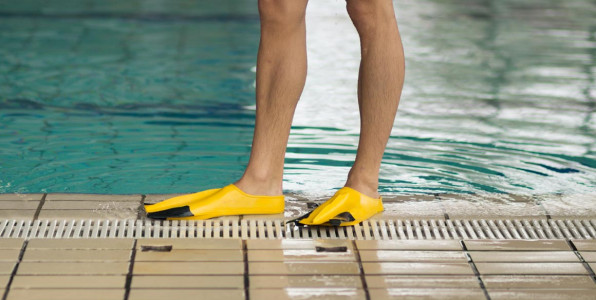
Review any website and you will find a variety of styles and blade lengths, but which is best for triathletes? The wrong style or blade length could affect your swim technique and how that translates into your kick when not wearing fins.
The length of the fin blade has a big effect on your kick. True, the longer the fin blade the more power you generate and the faster you will travel through the water, but does that translate into how you will swim without fins? No. The choice of blade length should match up with what kind of training you are doing and your type of kick. With long blade lengths, your legs have to work harder (due to increased water resistance) and hence your kick is slower. Different blade lengths serve different purposes. The best training lengths for triathletes is a short blade version, allowing you to develop your flutter kick, mimicking your kick when not wearing fins.
Short fins, create resistance in the water while forcing the swimmer to use a faster kick, making them ideal for freestylers. A short blade will help a swimmer develop proper kicking tempo and technique.
Notched fins (fin blades with a V-cut) are also intended for serious swimmers, as they mimic the natural path of the foot through the water. Most notched fins have the same short blade that promotes proper kicking technique.
The stiffer the fin blade, the more resistance it will provide. While this sounds appealing to those who want to increase leg strength, it also leads to a slower more ineffective kick without fins. Softer fin blade material provides a more natural movement through the water.
Some fins include ribs that direct the flow of water over the foot. The more the fin is designed to mimic the feel of swimming without fins, the better the benefit for the swimmer.
Another important thing to consider when buying a new pair of fins is how rigid they are. I would recommend that you get your hands on a pair you are thinking of buying to assess the stiffness for yourself. The stiffer the fins, the harder it will be to kick. While a stiff fin may be useful for getting fit and a harder workout out for your legs, they promote a slower tempo kick, which doesn’t benefit swimmers who are trying to get faster. Additionally, really stiff fins tend to dig into the top of your heel. To combat this or blisters that occur with regular use of fins, you have the option of wearing socks.
For other triathlete related products visit our triathlon shop to view a range of Tenola tri-suits >
Tenola founder and CEO Ian Nolan has a lifelong love of all things active and has competed in a variety of sports over the years involving mud, sweat and tears – the latter following various serious sporting injuries! But it was the challenge of the dual or tri-disciplines of Triathlon, testing not only fitness but endurance and skill that truly captivated him and led to an ongoing passion for the sport. Read More >